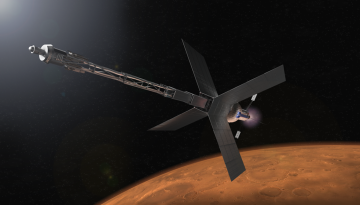Cornell University experts use NASA grant to study nuclear power cooling
As space exploration becomes more ambitious, Cornell Engineering researchers are using a NASA grant to investigate technologies for the vital energy systems that will enable missions to last longer and go farther, including nuclear power-enabled missions.
A NASA Space Technology Research Grant announced Dec. 1 is funding a project dubbed AdVECT – Additive Vehicle-Embedded Cooling Technologies – led by Sadaf Sobhani, assistant professor in the Sibley School of Mechanical and Aerospace Engineering. Co-investigators on the grant include assistant professor Elaine Petro and senior research associate Andrew van Paridon, both of the Sibley School.
The project aims to produce novel ceramic heat-rejection technologies suitable for nuclear power systems, including fission surface power, which could one day enable operation of a moon base, and nuclear electric propulsion, which could efficiently thrust rockets to Mars.
Sobhani and collaborators will develop new ceramic resins and additive manufacturing techniques to 3D print components such as porous ceramic radiators with embedded heat piping. X-ray imaging, thermal analysis and vacuum chamber testing will be employed to optimize the mechanical strength and other properties of the ceramics.
The goal is to overcome limitations in cooling technologies currently used for space exploration, such as radiators with metal-encapsulated heat pipes that are relatively heavy and would constrain future missions. Lighter carbon-composite alternatives are difficult to integrate into high-temperature radiators and may not be durable enough to withstand harsh space environments, according to Sobhani.
“Ceramics heat-rejection technologies are lightweight, high temperature, and mechanically robust,” said Sobhani, whose research group focuses on energy management technologies. “By leveraging additive manufacturing, we are able to further extend these advantages by enabling seamless integration between heat pipes and other components.”
Sobhani added that ceramic cooling systems can also increase the tolerance of pipe freezing and thawing by incorporating coolants that only ceramics can handle.
“Nuclear-power systems will help enable future manned and unmanned space missions. We are eager to contribute to developing a novel approach for thermal management of these future systems,” Sobhani said.

